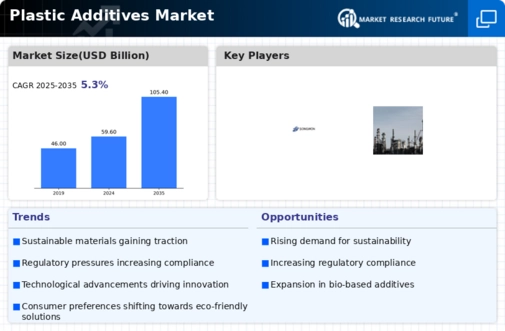Top Industry Leaders in the Plastic Additives Market
 The plastic additives market, a multi-billion dollar industry, thrives on its ability to transform ordinary plastic into versatile materials with specific properties. From enhancing durability to ensuring flame retardancy, these chemical compounds are the unsung heroes behind the diverse applications of plastics. Understanding the competitive landscape of this dynamic market is crucial for both established players and new entrants.
The plastic additives market, a multi-billion dollar industry, thrives on its ability to transform ordinary plastic into versatile materials with specific properties. From enhancing durability to ensuring flame retardancy, these chemical compounds are the unsung heroes behind the diverse applications of plastics. Understanding the competitive landscape of this dynamic market is crucial for both established players and new entrants.
Market Dynamics and Strategies:
The market is characterized by a few key players like BASF SE, Lanxess, and Exxon Mobil, who hold significant market share due to their extensive product portfolios and global reach. However, smaller regional players are increasingly carving out niches with innovative additives and cost-effective solutions.
Strategies employed by leading players:
-
Product diversification: Expanding product portfolios to cater to niche applications in high-growth segments like automotive and electronics. -
Technological advancements: Investing in research and development to create sustainable and bio-based additives to address environmental concerns. -
Regional expansion: Targeting emerging markets like Asia Pacific and Latin America with customized product offerings. -
Vertical integration: Backward integration into raw material production and forward integration into distribution channels to gain cost and control advantages.
Key factors influencing market share:
-
Product quality and performance: Providing additives that meet stringent regulatory requirements and offer superior functionality. -
Brand reputation and reliability: Building trust with customers through consistent quality and reliable supply chains. -
Pricing and cost efficiency: Striking a balance between competitive pricing and profitability, especially in price-sensitive segments. -
Sustainability and environmental impact: Offering eco-friendly and recyclable additives to cater to growing consumer and regulatory pressure.
Key Companies in the Plastic Additives market include
BASF SE (Germany),
SONGWON (South Korea),
Clariant AG (Switzerland),
Evonik Industries AG (Germany),
MC Group, Inc. (the U.S),
Albemarle Corporation (US)
AkzoNobel NV ( the Netherland),
Solvay SA (Belgium),
Chemical Industries (India), and
Styro Chemical Industries (India)
Recent Developments:
BASF also positioned VALERAS as an important addition in September 2022 to its plastic additives range when it debuted the product in September last year. The company says that VALERAS enhances plastic applications through sustainable benefits provided by innovative technical solutions and services that help realize a circular economy while achieving carbon neutrality. This broad offering includes various antioxidants and light stabilizers.
In March 2022 last year, BASF announced plans to increase production capacity for hindered amine light stabilizers (HALS) at facilities in Italy and Germany. These agents play a critical role in protecting plastics from UV radiation-induced degradation caused by free radicals; they are used extensively across many industries where long-lasting outdoor exposure can occur. HALS like Tinuvin from BASF act as useful UV absorbers, preventing radical-induced degradation reactions within polymers, thus prolonging their lifetime under sunlight exposure. In January, Songwon Industrial partnered with Omya AG which provides marketing and sales, customer services as well as logistical support for Songwon's complete range of PVC additives throughout the Latin American region.
In January 2021, BASF SE introduced a portfolio brand name for plastic additives that consistently meets customer requirements while also considering their needs regarding sustainability.
BASF introduced VALERAS in September 2022 which supplements their existing portfolio of plastic additives. The concept behind Valeras enables plastics to become eco-friendly through innovative technical solutions and services supporting the transition towards a circular economy, thereby achieving net-zero emission goals. Additionally, this all-inclusive offer includes various antioxidants & light stabilizers.
At InnoTrans 2022, held in Berlin, Germany, on September 7th, SABIC unveiled LNP THERMOCOMP AM DC0041XA51 compound specifically developed for pellet-fed additive manufacturing (PFAM/) as a flame-retardant carbon fiber-reinforced substance that meets the requirements of EU and US Rail for fire performance.
BASF’s Ultramid® polyamide was optimized in June 2022; this allowed a more environmentally friendly painting process for automotive parts.
In June 2022, Evonik presented POLYVEST® eCO, sustainable liquid polybutadienes.
BASF announced its plan to increase the production capacity of hindered amine light stabilizers (HALS) at facilities in Germany and Italy in March 2022. HALS such as Tinuvin, Chimassorb, and Uvinul from BASF are critical stabilizers in plastics and polymers. These HALS products help shield polymers from UV radiation damage and effectively check free radical-initiated degradation.

